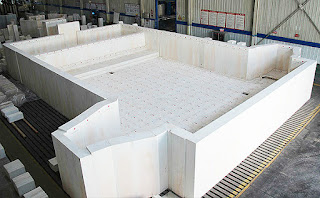Reasons for Loss of Refractory Materials for Glass Kiln Wall
The glass melting furnace is the heart of the float glass production line. The service life of the glass melting furnace mainly depends on the corrosion and burning degree of the wall of the melting furnace, the dam, and the regenerator. The corrosion degree of the pool wall is the key part that affects the life of the furnace.
The batch material is heated by the high-temperature radiation of solids passing through the flame along the longitudinal direction of the furnace. The first stage is the silicate reaction between various components in the raw material. The second stage is the unreacted foamy silicate ballast. The third stage gradually melts into molten glass. Na2O penetrates into the interior from the glass phase and pores of the wall tiles by means of penetration, diffusion, and substitution, and the protective layer is lost under the action of the temperature erosion of the glass liquid and the flow of the glass liquid. Alkaline oxide is the main factor causing the erosion of the pool wall.
 |
| Glass Furnace Refractory Bricks |
Due to the horizontal and vertical temperature differences in the furnace, there are actually various intricate convections of glass in the horizontal and vertical directions under the seemingly calm glass surface in the furnace. The chemical material zone, foam zone, and transparent glass area are not only heated by the flame but also heated by the molten circulating glass stream. It is these diversified convections that promote the melting, clarification, and homogenization of the glass, as well as the erosion of the pool wall.
From the practical experience of glass melting furnace production, the glass liquid level below 300 points, because the glass liquid has a low viscosity and a fast flow rate, it is a serious part of the pool wall erosion and erosion. The severely eroded part of the pool wall is the pool wall at the small furnace in the chemical material area at the junction of gas, liquid, and solid. Rather than the temperature hot spot at the junction of the gas and liquid phases on the wall of the small furnace. Therefore, the material pile close to the pool wall is easy to cause erosion of the pool wall.
 |
| AZS Bricks Used for the Glass Kiln Lining |
In addition to the above-mentioned loss of refractory bricks, the melting operation also has a serious impact on the erosion of the pool wall. Its main manifestations are:
(1) Unreasonable control of pool wall wind
Generally, the glass melting furnace adopts air cooling measures to protect the pool wall. By blowing and cooling the outside about 100 below the liquid level of the pool wall, the local temperature inside the pool wall brick is reduced, and the erosion of the pool wall brick by the pile and glass liquid is delayed. The pool wall cooling air plays a very important role in prolonging the life of the pool wall. Therefore, after the furnace is put into operation, the pool wall cooling air must be strictly controlled. One is to have a reasonable location of the pool wall, and the other is to have sufficient and stable pool wall air volume and blowing intensity. If the blowing position is unreasonable, or the blowing volume is too small and the blowing intensity is weak, the cooling air on the pool wall cannot be fully utilized. This results in faster erosion of pool wall tiles. Instability of pool wall wind control can easily cause the pool wall tiles to explode due to rapid heat and cooling.
(2) The stockpile is close to the pool wall
At present, most float glass manufacturers adopt the "double high heat load" melting operation system. Increasing the temperature of the small furnace by 1 to 2 will increase the temperature of the feeding pool correspondingly, causing the roots of the pile to be "live". Due to the melting operation, the temperature on both sides of the pool wall is lower than the temperature in the middle of the melting furnace, and the horizontal convection of the produced glass liquid will lead the material pile in the advancing process to the pool wall. Furthermore, large-scale float glass melting furnaces mostly use two blanket feeders, and each strand cannot be adjusted independently of the strand direction and other factors. The longer the time, the easier it is to form "inverted eight-shaped" piles that are inclined to both sides of the pool wall.
The skewed stockpile directly adheres to the small furnace pool wall bricks in the chemical material area and gradually melts, which has a greater erosion effect on the pool wall and accelerates the erosion rate of the pool wall bricks at the small furnace in the chemical material area.
Learn more about the refractories used for the glass kiln refractory lining: https://www.hy-refractory.com/service/product_knowledge/glass-tank-furnace-refractories.html.



评论
发表评论